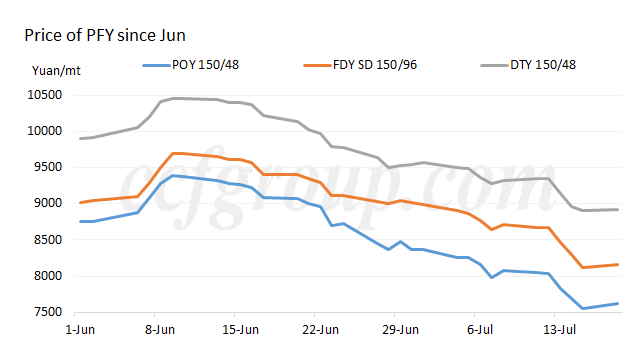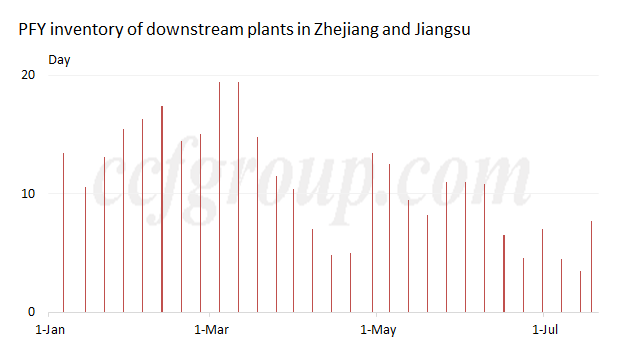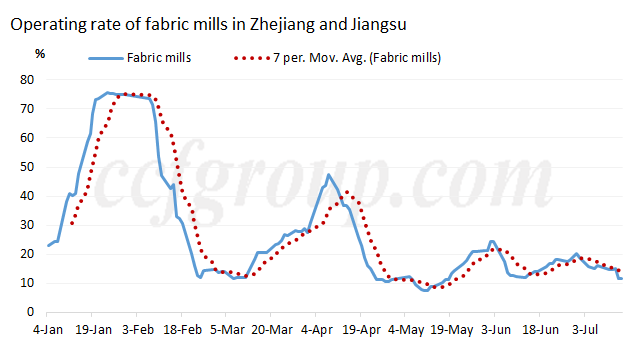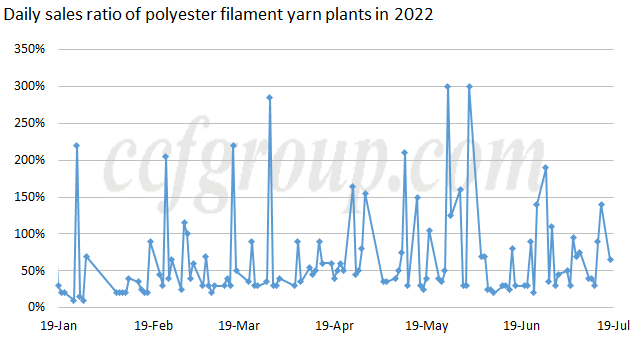PFY companies to resume operation driven by slightly better sales
Price of polyester POY has declined by near 2,000yuan/mt or 20% from Jun 10 to Jul 18 and that of FDY and DTY reduced less at around 1,650-1,700yuan/mt or 16-17%.

Price of PFY has been lower than the lowest level in end-Apr when downstream byers intensively replenished PFY.

By last Friday, the operating rate of DTY plants, fabric mills and printing and dyeing plants was as low as 47%, 51% and 55% respectively. However, orders for some fabrics for winter apparels such as knitted velvet fabrics improved from some e-commerce buyers.
After leading big PFY companies slashed run rate, the demand contradiction of PFY and terminal market is easing.

Feedstock market was firm since last weekend. PFY stocks of downstream plants were low and rising feedstock price supported players’ mindset. Speculative procurement grew recently. By Jul 18, the PFY stocks of downstream plants could mostly guarantee production into end-Jul.

Will PFY price continue increasing later? Will the operating rate of PFY plants recover? These are hot issues market players concerned.
In terms of price, when stocks of PFY are transferred to downstream market and the inventory burden is mitigated periodically, the profit of PFY is expected to improve and price of PFY may follow the uptrend on feedstock market. The feedstock market is anticipated to curve a similar trend as crude oil. The inventory of PFY keeps high and the quality of PFY stocks is worrying amid heat weather. Therefore, PFY producers will focus on selling and the increment of PFY will be restricted. In medium run, although the inventory of PFY plants has been mitigated, if downstream plants’ operating rate fails to rise effectively. PFY producers will encounter inventory burden again. In addition, PX market is likely to see mounting stocks from destocking later and the stocks of PTA may accumulate.
As for the operating rate, the inventory burden has been eased periodically and profit improves too. Some PFY plants who suspended or cut production earlier may resume operation. Without regard to the units that scale down production, some PFY plants who may resume production before end-Jul are as below:
| Company | Capacity (Kt) | Status | Product |
| Quandi | 250 | Heating up for restart | PFY |
| Tianlong | 200 | Heating up for restart | PFY |
| Lianda | 180 | Plans to restart near Jul 25 | PFY |
| Dongnan | 500 | Plans to restart near Jul 25 | PFY |
| Hengli | 200 | Plans to restart in end-Jul | PFY |
| Shenghong | 200 | Plans to restart in end-Jul | PFY |
| Huacheng | 360 | Heating up for restart near Jul 20 | PET fiber chip |
| Total | 1890 | Covering 2.7% of polyester capacity | |
However, downstream business has not improved with rising futures according to the survey made by CCFGroup. The order change on downstream market should be noted later. Intensively improving sales of PFY in recent period were mainly because of the following reasons: firstly, downstream plants’ PFY stocks have been low and most needed to restock to cover the pressing demand. Secondly, the absolute price of PFY was low after feedstock futures rallied and some players expected demand to warm up in Aug and Sep. As downstream plants intensively restocked and the heat weather slightly cooled down recently, the operating rate of fabric mills is estimated to increase in short run, up to 50-60% from 50%.
As terminal demand does not improve, sales of PFY may be hard to continue improving. Whether price of PFY can rebound will depend on the macro atmosphere and oil price. If macro market presents good atmosphere and oil price continues increasing, price of PFY may slightly climb up driven by cost side, while the stimulus from market fundamental fails to emerge temporarily. Downstream demand will not improve fundamentally before late-Aug. According to the survey made by CCFGroup, the actual demand is pessimistically estimated to not grow until late-Sep, rather than late-Aug. In addition, the demand in peak season may be lower than anticipation and the improvement is likely to be limited, which may last for around one month, from late-Sep to early-Nov. Speculative demand is anticipated to appear earlier than the real demand but it will rely on the performance of feedstock futures.
- Top keywords
- Cotton Price
- Cotton Futures Price
- Cotton Futures
- CZCE
- PTA Futures Price
- Chemical Fiber
- Polyester Prices
- Wool price
- PTA Futures
- Shengze Silk
- China
- Yarn Price
- price
- China Textile City
- Fibre Price
- Benzene Price
- Cotton
- Index
- Cotton Index
- PTA
- fabric price
- NYMEX
- Top 10
- textile industry
- Spot Cotton
- Cotton Yarn
- Polyester Price
- Futures
- PTA Price
- cotton yarn price

